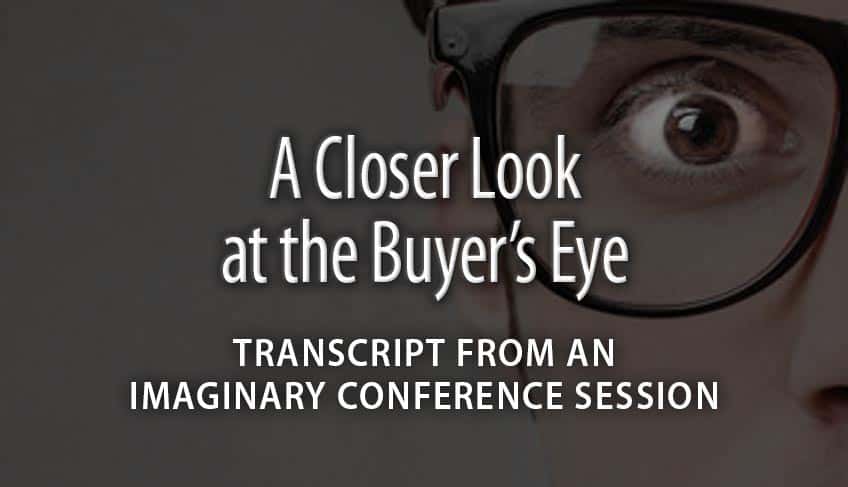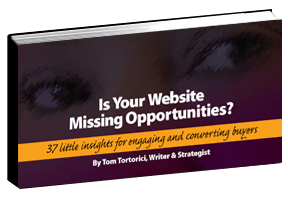
To keep the knowledge flowing during these risky times, I thought about putting on a virtual conference. But … that still seemed like too much work.
So join me for an imaginary conference session, via this imaginary transcript. From there, we’ll take an imaginary trip to the store.
Where is this all leading? Read on. Today’s lessons on higher-converting websites will be quite real …
CONFERENCE SESSION TRANSCRIPT
TITLE: A CLOSER LOOK AT THE BUYER’S EYE
TRACK: DIGITAL MARKETING
SPEAKER: TOM TORTORICI
Hi, and welcome to our imaginary attempt at a physical conference. In this session, we’ll explore the five modes of attention in the typical customer’s journey. Then we’ll look at ways we can get more engagement and response by synching our websites with those predictable modes. Sound okay?
Oh, and as we go along, if you have any questions, I guess just shout ‘em out.
Okay, um … how come I’m the only one in this class?
Ha – good question. Even though this is an imaginary physical conference, some on the organizing committee still felt we needed to set a social-distancing example by filling every other seat. But others felt that wasn’t safe enough. So yada yada yada, out of an abundance of caution, it was decided to allow only one attendee into each imaginary session. So, that’s how come.
Ah … okay …
Anyway, let me start out by asking you a question. Have you ever paid attention to your attention when you were in the market to purchase something?
Pay attention to my … ?
Well if you had, you’d notice your eyes, your visual attention, jumping around between these five modes: Scan; Focus; Search; Process; and Project.
Okay, from your blank stare, I see this may be easier with an example. So let’s say you’ve just walked into a retail store. Let’s say, oh … Bed Bath and Beyond.
Why … Bed Bath and Beyond?
Hm, not really not sure why I picked that. But we’re already there in our imaginations, so let’s go with it. Anyway, you walk in and you’re immediately surrounded by all kinds of home products, aisles and aisles of stuff. Maybe even a bit overwhelming, but in a good way. So can you picture yourself there? What are you doing?
Okay, let’s see. I’m … looking around, I guess.
Exactly! You’ve entered the first mode of attention: scanning. Eyes flitting from this to that as you walk down the aisle, scanning for, looking for … well, for what?
Oh, I dunno … something that looks cool, or interesting.
Then what?
Then … I guess I’d walk over and look closer at the color and details. Maybe pick it up, to get a sense of the texture, and the quality.
Exactly right. Now you’ve shifted to the second mode of attention, focusing. Your eyes are focused on something specific. Okay, what happens next?
Um, I look at the price tag, cringe, and put it back down.
Good. And then what?
And then … I guess I start looking around again. Back to ‘scanning mode,’ right?
Excellent. As you walk through the store, you’ll find yourself shifting back and forth between scan and focus, scan and focus, scan and focus. It’s what humans do, in all kinds of circumstances.
Interesting.
It is. Now, let’s say you remembered something you needed to buy, that you might find at Bed Bath and Beyond. Think of anything?
Ooh, yes, I’d love one of those soft plush toilet seats. The softer the better.
Ah … okay. So now what happens?
Now I’m on a mission, looking for the toilet seat department.
Yes, exactly, that’s the third mode of attention, searching. Now, while you’re walking, with your eyes peeled for toilet seats, do you happen to notice the throw pillows, or the soap dispensers?
Uh, no, not really. I’m not searching for those, so I don’t really see them.
No, you wouldn’t. So our perceptions aren’t really objective, are they? In this case, what you ‘see’ is determined by what you’re looking for.
Okay, so you’ve found your way to the toilet seat department; now what are you doing?
Okay, I’m … looking over all the toilet seats. I find a plush one, and pick it up to feel if it’s soft enough for my, well, y’know.
So, the scan and focus thing again. Now, do you grab it, and run up to the counter to pay for it?
No … not quite yet. I want to think about it first, because I don’t want to make a mistake. I notice it costs more than a regular toilet seat. I’m remembering the last plush seat I bought, that flattened out after a while.
Good. up until now, your modes of attention have been externally focused. You were looking out at things. Now, your buyer’s eye is focused inward, using the fourth mode of awareness, which we can call processing. You’re comparing options, drawing on past experience, and doing a quick risk/reward analysis.
Yeah … that sounds right. But I’m doing something else too.
Yes, you’re projecting – the fifth mode of awareness.
Projecting? Well, I’m thinking about sitting on this soft, warm throne first thing in the morning instead of a cold, hard one. Feels pretty good. So yeah, you’re right, I’m ‘projecting’ what the future will be like if I buy this.
Yes, with our eye again focused inward, we mentally try the item on, to see if our future-self will be happy with it. Sometimes we also project what others will think, because that influences us too. Will your houseguests say you’re a genius for having a nice plush toilet seat, or will they make fun of you for it?
Uh, knowing my friends, I think they’d be impressed.
Okay, so now that everyone’s happy in your imaginary trial run, what’s next?
I’m sold. I put Mr. Plushy under my arm and head for the shortest line.
So you’ve completed your buyer’s journey. To recap, do you remember the five modes of buyer awareness we’ve been through?
Yes … no. What was the first one again?
The five modes are scanning, focusing, searching, processing and projecting. In no particular order.
So … how can we apply these lessons, so our own websites synch with the five modes our potential buyer is experiencing?
No idea.
Then get ready to take notes.
Okay, ah, let me take out my imaginary pen.
First, make sure your site, especially your home page, is easy to scan.
That means catching the eye with visuals paired with prominent headlines and callouts. Each phrase offers a meaningful benefit or intriguing insight that invites scanning visitors to look closer.
Now think about website selling pages that are pretty much just plain text. That would be like removing all the products in the store, and giving walk-in customers a plain inventory list.
Yuck.
Exactly.
Second, give your visitors something to focus on next.
That could be a sub-head, a bite-size nugget of text, or a chart that gets secondary info across, before they go on to something else. Just like in the store, your web visitors are doing the scan and focus thing, over and over.
Some websites these days contain an absolute minimum of content, which in retail, would be the equivalent of having mostly empty shelves.
Ha – not a good experience, right?
You’re catching on.
Third, accommodate your web visitors who are searching for something specific.
Typically, those folks will start with the website menu. Unfortunately, even your most important pages may be ‘buried’ in a drop-down that’s not initially visible. Just as bad, all the site pages may be hidden away behind a hamburger icon.
So make sure prominent links to your most-searched pages are displayed elsewhere on your Home page. Kind of like how a store’s most popular items are displayed as soon as you walk in.
Um, I think this session is running overtime. The next class’s attendee keeps peeking in.
Shush. I’m almost done.
Fourth, link to product-specific web pages that help your buyer process a potential purchase.
Here, you’ll anticipate, and overcome, their objections. You’ll explain why this won’t be a repeat of previous bad experiences. And, for comparison purposes, you’ll specify exactly why your product or service is better than your competitors.
You know when a store worker comes over and asks if they can help you? You dismiss them with, “I’m just looking.” But what you’re really doing as you stand there is processing.
Excuse me, that loud buzzing noise, I think it’s the fire alarm. We should leave.
Oh please, it’s an imaginary conference, what exactly is going to burn down?
Anyway, fifth, and lastly, help your buyer’s inner eye project a happy outcome.
You can paint a picture with words – about how much better life will be with this new product or service. How others will compliment and envy them. How they’ll be one step closer to the ‘better self’ they aspire to be.
I mean, don’t go overboard. Just as processing is chiefly logical, projecting is mostly emotional. Here is where you’re most likely to clinch the deal, whether they’re in front of the store shelf, or in front of their laptop.
Okay … that’s about it for this session. The main takeaways, as you can see on this slide, are the buyer’s five modes of attention:
Scan
Focus
Search
Process
Project
So, any questions?
Hello?
Hm, I guess my imaginary attendee left early, and I’m still standing up here yapping …
Share It:
 About the Author: Tom Tortorici is an Atlanta copywriter and web content writer who helps companies make a genuine connection with their audience. His classes and conference presentations have focused on how writing, strategy and design can work together to grab attention and interest even among readers with short attention spans. In addition to working directly with businesses, Tom regularly partners with web designers and marketing agencies.
About the Author: Tom Tortorici is an Atlanta copywriter and web content writer who helps companies make a genuine connection with their audience. His classes and conference presentations have focused on how writing, strategy and design can work together to grab attention and interest even among readers with short attention spans. In addition to working directly with businesses, Tom regularly partners with web designers and marketing agencies.
All Posts/Subscribe >
Info for Businesses >
Info for Designers/Agencies >
Tom Tortorici Inc. | Tom@TomTortorici.com | 770-934-7861 | 3101 Rockaway Rd | Atlanta GA 30341

